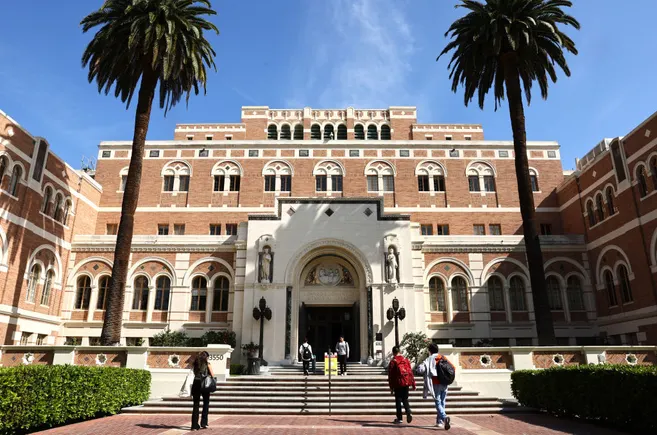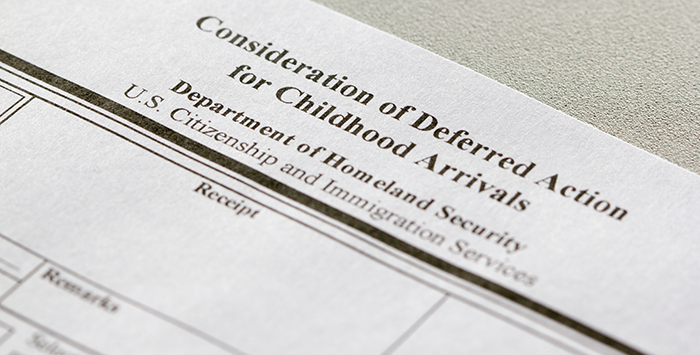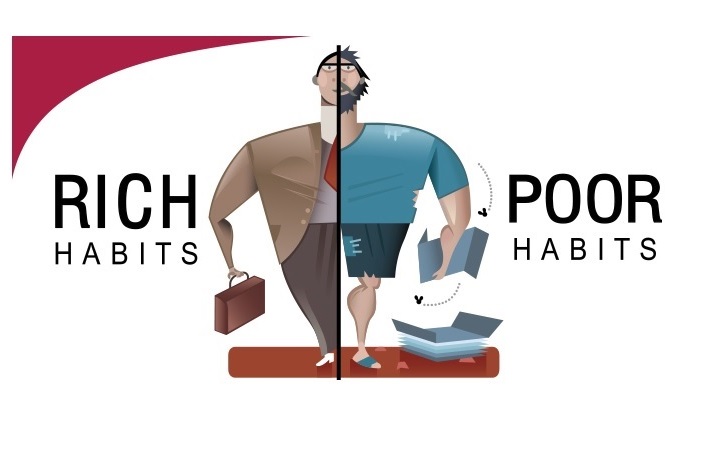This is a moment for higher education 18 years in the making.
By the latest estimates, 2025 will be the year that the number of high school graduates peak. The long-dreaded demographic cliff — caused by declining birth rates starting in 2007 — is coming.
But the coming decline in traditional-aged college students might not be a “cliff,” exactly, and it doesn’t necessarily spell a disaster for the nation’s colleges.
In its latest forecasts of future high school graduate numbers, the Western Interstate Commission for Higher Education described a more gradual drop over the next 15 years than the cliff metaphor suggests, though it also projected a slightly larger decline overall than previously expected.
“The decline is coming,” Patrick Lane, report co-author and WICHE’s vice president of policy analysis and research, said during a February panel at an American Council on Education event in Washington, D.C. “Whether it looks like a cliff or sort of a slowly sliding downward trend … that’s the really big question.”
A more gradual decline would give institutions and policymakers time to prepare and manage the change. After all, diminished numbers of high school graduates don’t necessarily have to translate into fewer college students — though they probably will for certain institutions. The college-going rate, along with college student body makeup and retention, all play a role in mitigation strategies amid the decline.
However colleges and policymakers respond, it’s time for them to get ready. As Lane emphasized, the decline will be real — and it’s nearly here.
“The reason that we’re pretty confident about this is because you can’t create 18-year-olds out of nothing,” he said. “There just aren’t the bodies anymore.”
Fewer students, more closures
Demographic shifts have already caused financial pain for many institutions, with some states already seeing their ranks shrink. In the Northeast — home to many of the country’s private liberal arts institutions — high school graduate numbers fell from 637,000 in 2012 to 612,000 in 2024, a drop approaching 4%.
When Wells College in New York and Goddard College in Vermont shuttered last year, both cited demographic challenges.
Those and other recent college closures highlight the challenge in adapting to the sector’s changes.
Such closures “may represent institutions that didn’t act strongly enough soon enough, or else they were just overwhelmed by forces that were bigger than were possible to overcome,” said Nathan Grawe, an economics professor at Carleton College and author of “Demographics and The Demand for Higher Education.”
But as populations of traditional-aged college students shrink more broadly and deeply, the pace of closures could accelerate.
A study released in December used machine learning techniques to forecast changes in college closure rates tied to the demographic cliff. The model, developed by researchers with the Federal Reserve Bank of Philadelphia, predicts that up to 80 additional colleges could close with an abrupt 15% decline in enrollment (from a 2019 baseline, chosen to avoid COVID disruptions) over the 2025-29 period.
That would effectively more than double the current average annual closure rate of institutions. While this represents a worst-case scenario, even gentler declines could still wreak havoc on some institutions. The researchers found a more gradual enrollment decrease happening over five years would lead to an 8.1% increase in annual college closures, or about five additional institutions per year.
An institution’s size and stature could determine how it weathers coming population changes.
“Especially full-time traditional-age students are looking to go to the bigger-name universities if they can, which is further stressing some of the smaller colleges that are already facing enrollment declines,” said Robert Kelchen, a visiting scholar at the Philadelphia Fed’s Consumer Finance Institute and one of the paper’s authors.
Location also matters.
WICHE’s projection of peaking high school graduates — at around 3.8 million this year
— represents a national average. But outcomes by state vary widely, with some actually forecasted to see increases rather than decreases.
Demographics will play out differently throughout the U.S.
Projected changes in the high school graduate population from 2023 to 2041 by state
Meanwhile, some locations and regions will experience steeper-than-average declines. Between 2023 and 2041, WICHE researchers estimate, graduates will drop 27% in New York and 32% in Illinois, for example. By contrast, are projected to grow by double digits in some states, including Tennessee, South Carolina and Florida.
Many struggling colleges “are in the Northeast and Midwest, which are on the higher side in terms of expected enrollment declines,” said Kelchen, an educational leadership and policy studies professor at the University of Tennessee, Knoxville. That means those institutions are likely more vulnerable.
‘Going on offense’ to raise attendance rates
Not every high school graduate chooses to attend college. And in recent years, a smaller proportion have done so. Between 2016 and 2022, the college-going rate fell about 8 percentage points to 62%.
Raising that rate could significantly help offset enrollment losses. WICHE found that increasing the college-going rate by just 0.5% per year would more than offset the enrollment shortfalls from demographic shifts. But increasing college attendance rate is no simple or easy task — nor is it entirely in anyone’s control.
Much depends on the economy and job market.
Wage growth over the past decade could help explain lower attendance rates. “This is what it looks like to reduce inequality, but it does mean that students who are on the bubble between the job market and higher ed are more likely to choose the job market until that trend reverses,” Grawe said.
College attendance rates have fallen in recent years
Rates of immediate enrollment of high school graduates in a postsecondary institution
Increasing skepticism about the value of college education also likely plays a role. Kelchen pointed to a “perception that college is unaffordable.”
In fact, net tuition and fees have declined over the past decade at both public and private institutions, studies have shown.
“That’s different than the previous four decades, but that perception is there,” he added. “Students have some pretty inexpensive options, especially with the growth of free community college programs. But those aren’t going to save some of these small private colleges that are struggling to compete on price.”
And while college’s net price increases have slowed — attendance still comes with a heavy price tag for many.
“College costs too much. It takes too long,” said Chuck Ambrose, a senior education consultant with law firm Husch Blackwell who has served as chief executive at several colleges. “At the end of the day, you’ve got to borrow to pay, which leverages all that potential over a longer span” before benefits are realized.
So, not only does the economy affect college attendance — college attendance affects the entire economy.
“It’s our game to lose because the kind of demand that we’re going to continue to see on the need for postsecondary [skills] is going to be quite high,” Jeff Strohl, a professor and director of Georgetown University’s Center on Education and the Workforce, said during the ACE panel.
The higher education sector “really needs to go on the offense,” he said, focusing on skills graduates need in the job market and recognizing that “education is, in fact, putting together packets of skills that match with occupations and packages of need, while not losing our commitment to general education.”
‘If we just kept the students we have, we’d be healthy’
The idea that demographic decline will usher in an “apocalypse” for higher ed institutions is an “unhelpful” notion, Grawe said at the ACE event.
“If it’s an ‘apocalypse,’ we go home and we throw in the towel,” he said.
Difficult as adjusting may be, institutions have some agency, experts have made clear. But that adjustment will likely require investments in services and infrastructure — and breaking old institutional habits.
“It’s really important that you be realistic,” Grawe said in an interview. “If you say, ‘Well, we’re going to just recruit our way out of this mess,’ but then you don’t recruit your way out of this mess — now you have really, really large budget shortfalls.”
“It’s really important that you be realistic. If you say, ‘Well, we’re going to just recruit our way out of this mess,’ but then you don’t recruit your way out of this mess — now you have really, really large budget shortfalls.”
Nathan Grawe
Economics Professor, Carleton College
It’s also important to remember that the pool of potential students is larger than just the annual waves of high school graduates. For one, there’s all the students currently enrolled in college — many of whom, statistically, won’t stick around to graduate. By the National Student Clearinghouse Research Center’s latest count, the national completion rate stood at 61.1% for students who entered college in fall 2018.
WICHE’s thought experiment with improving college-going rates could also be conducted looking at retention rates, Lane said in a December interview, adding that retention is “absolutely part of the puzzle” of managing the demographic decline.
Better retention could have a large, positive impact financially for many colleges in the face of a shrinking pipeline for new students.
“If we just kept the students we have, we’d be healthy,” Ambrose said of the sector. “Students hire us to do three jobs. Recruit them, keep them and make sure their experience is of value.”
But like the college-going rate, if improving retention were easy, it would be done. “There’s no telling how many billions of dollars we spent on interventions and staff and analytics and all kinds of tools,” Ambrose said.
With retention broadly, it could take a kitchen-sink approach to succeed. Ambrose listed a host of strategies that can help colleges retain their students, including expanding campus work, internship and apprenticeship programs; incentivizing completion, such as through scholarships; and providing personalized, comprehensive student support.
Put simply, boosting retention rates requires investment. In an interview, Grawe pointed to City University of New York’s ASAP program for students seeking associate degrees. (CUNY has a similar program for bachelor’s students).
ASAP provides financial assistance for tuition, transportation and textbooks on top of intensive counseling and what Grawe described as “supports that may speak to a sense of belonging.”
CUNY has found the graduation rate for ASAP participants to be 53%, more than double historical rates.
“They’ve had tremendous, tremendous success, more or less doubling the share of students who are completing their associate’s degrees,” Grawe said. “Now the downside is that program is wraparound, which means it’s very expensive. But if you look at it on a per-degree basis, it doesn’t look nearly so expensive.”
Not every effort needs a wealth of funds or to be as comprehensive to make a difference, though.
Grawe also pointed to the University of Southern Maine, which last year showed some of the most dramatic improvement in its student retention rate across the University of Maine System, at 77.3%, up from a low of 70% four years prior. The institution turned retention around “by focusing just on just basic nuts and bolts of student advising,” Grawe said.
UMS as a whole hit a record student return rate last fall. The system credited the rise in part to “intrusive advising.” That includes such things as sending text alerts to students who miss classes or fall behind on their assignments. The messages then invite them in for advising or counseling appointments.
Equity as an ‘imperative’
Equity and inclusion also play an ever more important role in retention. Future student bodies are projected to become more diverse, with WICHE forecasting rises in Hispanic and multiracial students.
College was “meant to be for privilege,” Ambrose said. “If you put the supports in place that reverse these trends, you know we call it? Equity.”
He also noted, “The impact of dismantling DEI also dismantles our greatest potential to survive.”
Strohl echoed that point during the ACE panel, which occurred against the backdrop of the Trump administration’s all-out attack on higher ed diversity, equity and inclusion programs.
“We’ve been afraid of, or we’ve been made afraid of, the word ‘equity,’” Strohl said. “Right now, equity is going to be an economic imperative for the healthy growth of this country, and we need to figure out how to get all hands on board as we move forward.”
He went on to explain that educational institutions must find ways of “picking up the people who have been left behind” — including both racial minority groups and low-income White people — to meet the skills gap.
Pivoting to adult students: ‘A years-long process’
Nontraditional student recruitment is another possibility with promise, but, as with boosting retention, it requires investment as well as major cultural and operational changes in the higher ed world.
In Ambrose’s view, college historically was a “four-year holding tank to assimilate young people into the workforce.”
“Our campuses, infrastructure, facilities, schedules and intended outcomes are still designed to serve 17-to-24-year-olds,” he noted.
“Our campuses, infrastructure, facilities, schedules and intended outcomes are still designed to serve 17-to-24-year-olds.”

Chuck Ambrose
Senior Education Consultant, Husch Blackwell
Reaching older students is not easy, nor is there a straightforward playbook for how to do it. “You cannot become an adult-serving institution overnight,” Lane said at the ACE event. “This is a yearslong process.”
Knowing what works to attract and retain adult learners is an understudied topic — making it all the more difficult to act on.
“We don’t really know what works, because we don’t really have great data,” Lane said. “We don’t know, at the intervention level,” what improves credit-earning, retention, and college completion for adults, he said.
Grawe echoed that caveat during the panel. “I hear too many institutions who respond to declining traditional-age students by saying, ‘Well, we’ll just shift toward adults’ — as if it’s a light switch.”
Pivoting to attract more nontraditional students means “fundamentally rethinking how we do almost everything,” Grawe added.
“We need to think about what it means to attend college with kids. What does it mean to attend college with jobs? Those are very, very different learning environments,” he said. “And so to simply say, ‘We will go out and tell adults, ‘Well, now you are welcome here too, and they will of course want to hang out with us,’ I think is very misguided.”



























